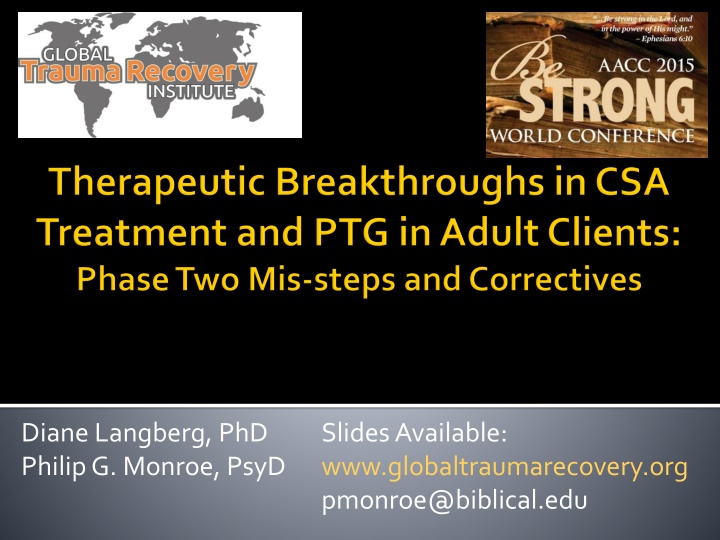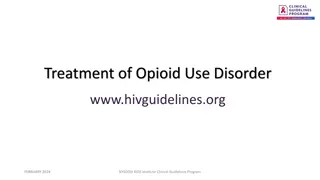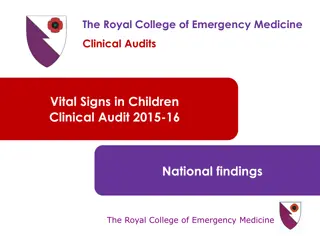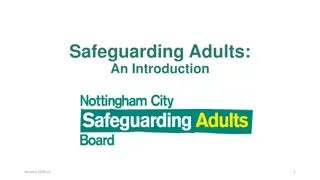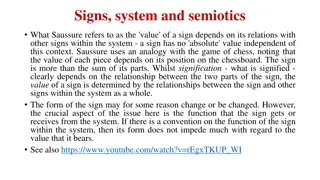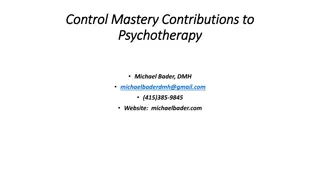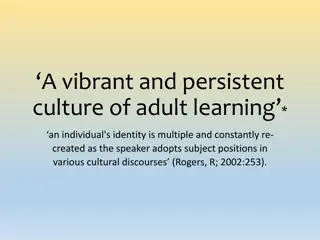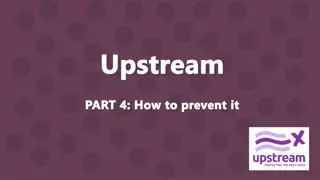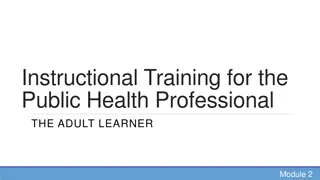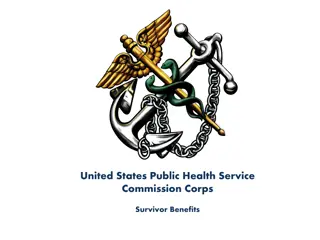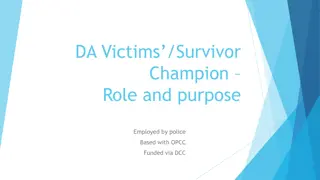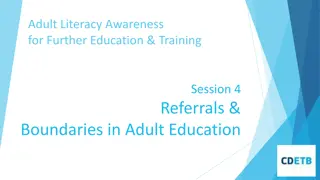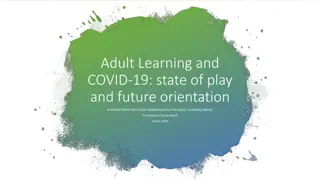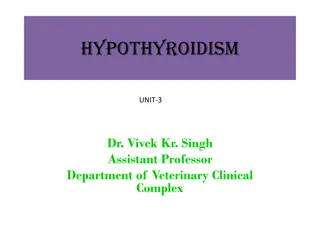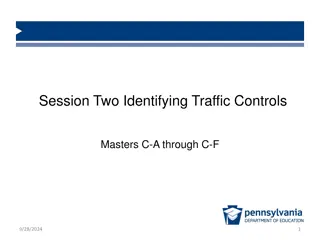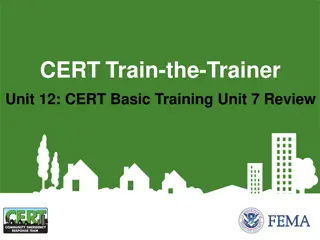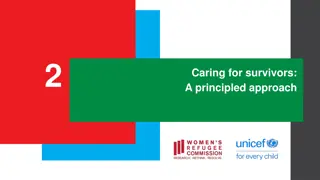Clinical Mistakes in Adult Survivor Treatment & Signs of Growth
Identify common clinical mistakes in treating adult survivors of child sexual abuse, best practices for treatment, and signs of posttraumatic growth and resilience in clients. Understand the significance of different symptoms like re-experiencing, avoidance, and dissociation. Learn about the impacts of over-responsibility, boundary crossings, and burnout. Explore the importance of addressing dissociative problems such as derealization and depersonalization for effective intervention strategies.
Download Presentation

Please find below an Image/Link to download the presentation.
The content on the website is provided AS IS for your information and personal use only. It may not be sold, licensed, or shared on other websites without obtaining consent from the author.If you encounter any issues during the download, it is possible that the publisher has removed the file from their server.
You are allowed to download the files provided on this website for personal or commercial use, subject to the condition that they are used lawfully. All files are the property of their respective owners.
The content on the website is provided AS IS for your information and personal use only. It may not be sold, licensed, or shared on other websites without obtaining consent from the author.
E N D
Presentation Transcript
Diane Langberg, PhD Philip G. Monroe, PsyD Slides Available: www.globaltraumarecovery.org pmonroe@biblical.edu
Identify common clinical mistakes in the treatment of adult survivors of child sexual abuse Describe best practices during phase two of treatment Understand common signs of posttraumatic growth and resilience within clients that appear stuck
The client? Or the counselor?
How can I get my client to? How can I get rid of my client?
Messianic rescuing (over-responsibility) Boundary crossings or Burnout Demanding catharsis Forcing memory processing/exposure Misunderstanding client resistance Irritated with client; push harder Failure to manage the hour Encouraging dissociation
Re-experiencing: (1) Recurrent, intrusive distressing recollection (may be repetitive play) Recurrent, distressing dreams Acting or feeling as if event is recurring Psychological distress on exposure to cues Physiological reactivity on exposure to cues Increased arousal (2) Difficulty falling or staying asleep Irritability or outbursts of anger Difficulty concentrating Hypervigilance Exaggerated startle response Avoidance or Numbing (3) Efforts to avoid thoughts, feelings, conversations associated with trauma Efforts to avoid activities, places, or people associated with trauma Inability to recall important aspect of trauma Diminished interest or participation in significant activities Feeling of detachment or estrangement from others Restricted range of affect Sense of foreshortened future
Pays more attention to dissociative problems Derealization Depersonalization Sees these symptoms as separate from re- experiencing and/or hypervigilance Why important? Clients with this set of symptoms respond better to mindfulness, cognitive restructuring, and DBT style interventions in addition to exposure therapies Note: also preschool subtype
Betrayal trauma experiences leading to symptoms of complex PTSD Hypervigilance Distorted sense of self Addictions Eating disorders Sleep disorders Shame Dissociation Self-hatred Fear Confusion Distrustful Distorted view of God Control seeking Self-destructive behavior Emotional numbness
1. Ability to regulate affect and impulses 2. Attention and consciousness 3. Self-perception 4. Perception of the perpetrator 5. Capacity for relationships 6. Body and brain responses 7. Perception of meaning and faith
DESNOS BPD Primary Affect: Panic and pain Has capacity for positive affect Relationships: Passive, avoidance, re- victimization Vacillates between desire and devaluation Dissociation: Present, chronic Transient, if present Idealized identity Cognitive Focus: Fear, avoidance Self: Consistent self loathing Confused
Foundation for all treatment Longest phase and vital to positive outcomes Features Therapeutic alliance building Education about the nature of trauma Managing vs. reacting to symptoms
Memory work done in concert with phase one skills Focus: grief, loss, shame, anger rather than anxiety Context: the tendency to leave (dissociate from) the pain Goal: Small amounts of memory work with frequent self-care and stabilization
Exposure Stress inoculation OR ? Interpersonal/dynamic interventions Therapy that emphasized relaxation, relationships, affect, and meaning-making appeared to be more helpful than therapy that emphasized exposure to trauma reminders. D Andrea & Pole
Intense fear, paralysis/helplessness, inability to effect any change, threat of annihilation, leading toexperience of, Loss of voice, control, connection, and meaning, resulting in, Disorganized physical, cognitive, and emotional response systemthereby increasing, Relational pain, distrust, self-contempt, overwhelming anxiety, evidenced as, Running from the past, afraid of the future
Proceed little by little, without force Focus on this step over ultimate goal Embrace repetition Embrace rest; Identify as NOT failure Remember: Return to safety/stabilization throughout treatment
Attachment Self-Regulation Competency Kinniburgh, Blaustein, Spinazzola, Psychiatric Annals, May 2005 http://psychrights.org/research/Digest/CriticalT hinkRxCites/kinniburgh.pdf
Predictable routines in therapy Support in-the-moment affect regulation Watch your language Affirm strengths (find them in surprising areas!)
Expand awareness of affect Connect affect with body sensations Normalize reactions Self-expression through nonverbal means Encourage kinetic regulation of affect Connect affect with historical events Teach grounding techniques
Identify interests/goals Encourage independent choices Learning relational safety/danger cues Encourage connections to others Identify and affirm strengths Teach self-awareness self-care Construct solutions to problems together Review outcomes together
Mindfulness is about waking up from a life on automatic pilot, becoming keenly aware and sensitive to our experiences both internal and external
On creation On Scripture On Christ
Goal: having a sanctuary of the heart so we are not controlled by people or noise
Retrospective perceptions of positive psychological changes after trauma Not just bouncing back but growing beyond pre- trauma adaptive capacities Connotes positive change in identity and capacities post trauma
Changes seen in Identity perception (perceived new possibilities) Capacity awareness (strength perception) Appreciation of life and faith (values) PTSD PTG
Holding symptoms and strengths together Success during phase two includes Ability to say no Ability to have hope Not reduction of triggers and trauma reactions
Why do most recover from traumatic experiences and do not go on to develop PTSD? Intrinsic capacity? Community supports? Prior experiences?
resilience the power or ability to return to the original form, position, etc., after being bent, compressed, or stretched; elasticity. ability to recover readily from illness, depression, adversity, or the like; buoyancy. http://dictionary.reference.com/browse/resilience
the ability to recover readily from illness, depression, and adversity Adapting? Thriving? Problem with this definition? What does resilience look like in an ongoing storm?
Joseph? What you intended for evil Jeremiah? I will never forget this awful time as I grieve yet I still dare to hope Esther? If I perish, I perish Paul? Outwardly we are wasting away, yet inwardly Psalm writer Do the dead praise you?
http://t1.gstatic.com/images?q=tbn:ANd9GcRYkR-z6SffCmavZKZ00hmaoSmUK6KQZCuaFpxAdnUJuM_gDxcomAhttp://t1.gstatic.com/images?q=tbn:ANd9GcRYkR-z6SffCmavZKZ00hmaoSmUK6KQZCuaFpxAdnUJuM_gDxcomA Optimism (realistic optimism) Cognitive flexibility Personal moral compass Role models Face and reframe fears Active coping mechanisms Attending to physical wellbeing Nurture social network Recognize strengths Dennis Charney
YES! Gratitude Pride in culture and ethnicity Appreciation of human differences Karma
Fear/Reward circuits Neuropeptide Y?
Passive acceptance of threats Loss of social support and moral foundation Rumination
Possible ways to improve it CBT Narrative work Faith engagement Mindfulness Social Support Self-reflection Physical training Sleep
Phase 1: Interventions avoid disrupting intact protective factors (meaning, networks, structures) Phase 2: Re-establish weak social resources (family re-unification, vocational training) Phase 3: Targeted trauma recovery intervention
Communitys inherent capacity, hope, and faith to withstand major trauma, overcome adversity, and to prevail, with increased resources, competence and connectedness Judith Landau Individual resilience promoted by community and Community expression of resilience
Active use of family/community resilience stories Active engagement of transcendence Organizational strength Flexibility Connected Available resources
Identify agents of change Identify local values, resources, wisdom Reinforce open dialogue, to Identify tangible assets (community genogram) Re-establish daily patterns, rituals Re-connectedness
Use of drama to capture lament To validate, narrate To spark conversations Local conversations where all parties have voice Goal identification Resource allocation Support groups
DIANELANGBERG.COM GTRI/BTS www.dianelangberg.com Free audios/videos Links to books Audio library Note: Sales table after Wed night Plenary by Diane Book signing at conference: Suffering and the Heart of God: How Trauma Destroys and Christ Restores www.globaltraumarecovery .org Essays, videos, educational opportunities www.biblical.edu Free videos anyone can watch Low price NBCC approved CEs Dissociation Narcissism Making the Church a Safe Place
